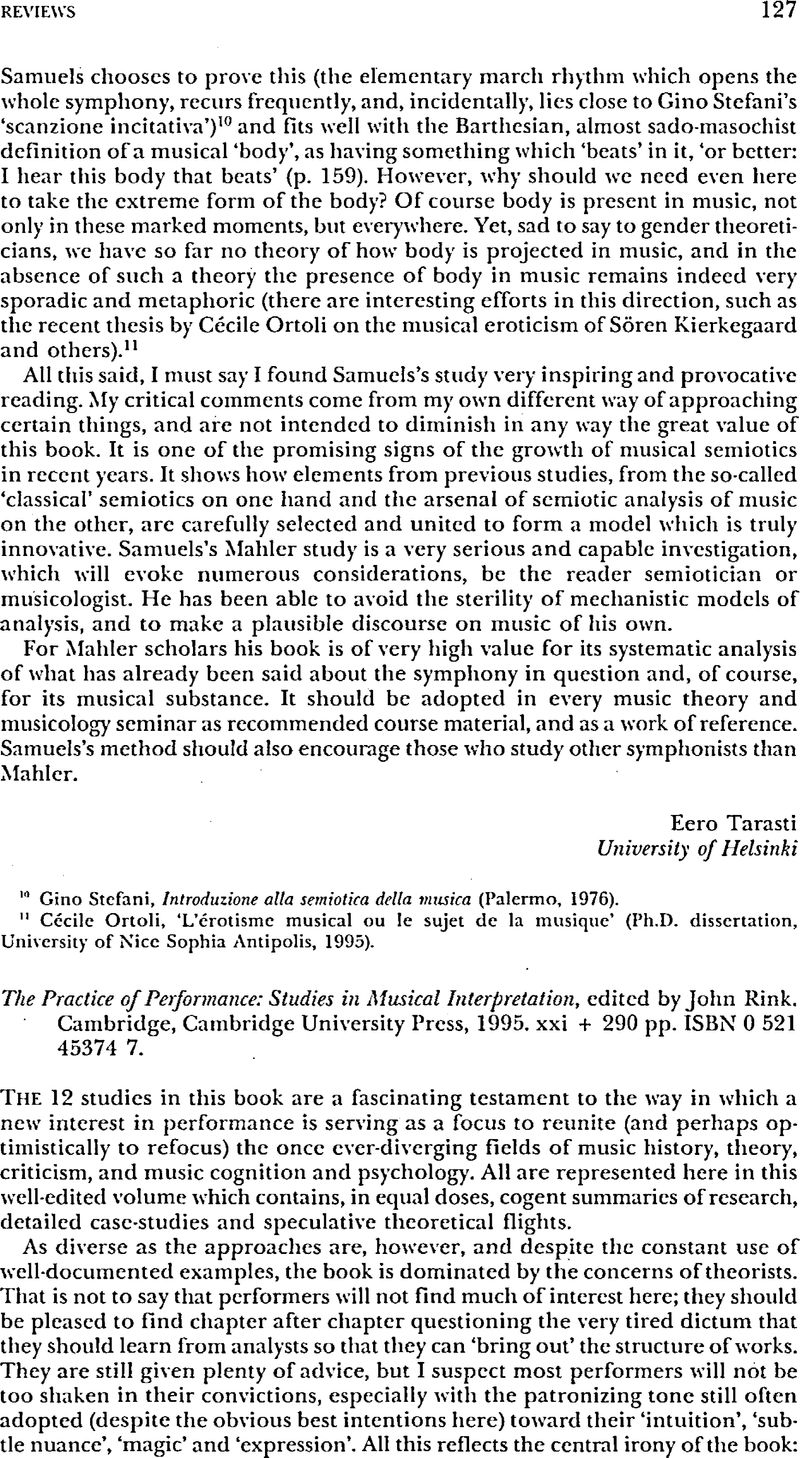No CrossRef data available.
Published online by Cambridge University Press: 01 January 2020

1 Clarke argues that it would be hard to imagine a situation in which a listener would have to know a performance style in order to decode the meaning of an expressive nuance (p. 27), but we need to investigate whether any of these expressive devices arc bound to specific repertories, and whether expert and novice performers use the same tools.Google Scholar
2 Supposedly, the best predictor of success in nursery children is not intelligence or reading skill, but whether or not they arc willing to wait five minutes for two treats rather than taking one immediately. I suppose this means that all our attempts to make learning fun have the potential to help only the average and below-average student.Google Scholar
3 See also Eric Clarke, ‘Structure and Expression in Rhythmic Performance’, Musical Structure and Cognition, ed. Peter Howell, Ian Cross and Robert West (London, 1985), 209–36; Caroline Palmer, ‘Mapping Musical Thought to Musical Performance’, Journal of Experimental Psychology: Human Perception and Performance, 15 (1989), 331-46; Bruno Repp, ‘Diversity and Commonality in Music Performance: An Analysis of Timing Microstructure in Schumann's “Träumerei”’, Journal of the Acoustical Society of America, 92 (1992), 2546-68; Neil Todd, ‘A Model of Expressive Timing in Tonal Music’, Music Perception, 3 (1985), 69-88; and many other sources.Google Scholar
4 Campbell, Bruce, in his review of Janet M. Levy, Beethoven's Compositional Choices: The Two Versions of Opus 18 No. 1, First Movement, Studies in’ the Criticism and Theory of Music, 1 (Philadelphia, 1982), in Journal of Music Theory, 29 (1985), 187–97, makes the point for Levy: ‘surely one of the functions of analytical insight is to show how all but one of the apparent or “theoretical” possibilities are artistically untenable in a given context'.Google Scholar
5 See Berlioz, Hector, ‘Address to the Members of the Academy of Fine Arts of the Institute’ (1861), Mozart, Weber, and Wagner, with Various Essays on Musical Subjects, trans. Edwin Evans (London, 1918), 82–3. This metaphor recurs throughout the nineteenth century.Google Scholar
6 All three, and several others in this volume, are perhaps trying to show that there is no conflict between the intuitive and the musicological.Google Scholar
7 That said, I have not heard Cone play this piece himself and can make no judgment on how he might make this connection in performance.Google Scholar
8 Alfred Brendel (Vox PL-12390; n.d.), Edwin Fischer (Pathé COLH-68; 1938), Walter Gieseking (Angel 35533; n.d.), and Artur Schnabel (Victor LVT-1019; n.d.).Google Scholar
9 Jonathan Dunsby, ‘The Multi-Piece in Brahms: Fantasien Op. 116’ Brahms: Biographical, Documentary and Analytical Studies, ed. Robert Pascall (Cambridge, 1983), 167–89, and David Epstein, ‘Brahms and the Mechanisms of Motion: The Composition of Performance’, Brahms Studies: Analytical and Historical Perspectives, ed. George Bozarth (Oxford, 1990), 191-226.Google Scholar
10 But why did Brahms write ‘Un poco meno allegro’ instead of minim = minim or dotted minim = minim if he wanted such an exact relationship?Google Scholar
11 Seeing unity and coherence is a product of an act of interpreting and not necessarily of the thing itself. Any attempt at understanding will strive for coherence, but if the point of analysis is to show coherence, then the theory which demonstrates the most coherence wins, and the piece and performance which are the most coherent are the best.Google Scholar
12 Of course, there are other possibilities; if performance is about playing against structure, as Rothstein suggests, then we can both keep our jobs.Google Scholar
13 Helena Matheopoulos, Maestro: Encounters with Conductors of Today (London, 1982), 444.Google Scholar
14 Of course, Rink and Epstein do this too, but as the performers in question are themselves, it seems rather different.Google Scholar
15 Nicholas Cook, Analysing Musical Multimedia (Oxford, 1997).Google Scholar
16 Lester gives a good example of this where he notes (pp. 209–10) that in the opening of the Brahms Intermezzo, op. 118 no. 1, the downbeat of bar 2 (which is marked by an accent) needs to be connected with the preceding right-hand octave in order to hear the motive (![]() ).Google Scholar
).Google Scholar
17 The problem is exacerbated in jazz, where the normal aesthetic criteria often seem irrelevant. Billie Holiday has a horrible voice, Thelonious Monk cannot keep a beat and Miles Davis can barely play the trumpet. Exaggeration aside, all of these artists took what would normally be musical deficiencies and made them into artistic trademarks. Jazz musicians are rarely faithful to any original; ‘make it your own’ rather than ‘let the music speak for itself is the creed. While they may be criticized for altering the music to display their own idiosyncrasies, we also praise this practice; it is what gives Holiday, Monk and Davis a recognizable ‘style'.Google Scholar
18 Correctness is simply too dull. If it is an aesthetic value it is a minor one. Much like the choice between Schenker and Horowitz suggested above, given a choice between correctness and beauty, revelation or that little chill down your spine, correctness does not stand a chance.Google Scholar
19 'Die Natur erklären wir, das Seelenleben verstehen wir.’ Wilhelm Dilthey, Gesammelte Schriften, 14 vols. (Göttingen, 1913-67), v, 144.Google Scholar
20 This might also have brought a greater emphasis on the listener or audience to the book.Google Scholar